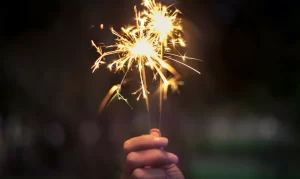Physical Address
23,24,25 & 26, 2nd Floor, Software Technology Park India, Opp: Garware Stadium,MIDC, Chikalthana, Aurangabad, Maharashtra – 431001 India
Physical Address
23,24,25 & 26, 2nd Floor, Software Technology Park India, Opp: Garware Stadium,MIDC, Chikalthana, Aurangabad, Maharashtra – 431001 India

By Vivek Saini
In a pivotal clarification on November 7, the Supreme Court of India resolutely reiterated its stance on the nationwide firecracker ban, extending beyond the National Capital Region (NCR). This judicial pronouncement is a crucial directive against using firecrackers containing barium and other prohibited chemicals. The primary objective remains to mitigate air and noise pollution during Diwali celebrations and beyond.
Scope and Evolution of Supreme Court Orders
In October 2018, the Supreme Court issued orders prohibiting the sale and production of all firecrackers except ‘green crackers’ and those with reduced emissions or improvements. The ban encompassed ‘joined crackers’ and barred the use of barium salts in firecrackers, emphasizing the need for noise levels to adhere to prescribed limits. This directive was reiterated in an order on October 29, 2021. Despite a plea from the firecracker manufacturers’ association in September, the court rejected permission for the use of joined crackers and the addition of barium salt to green crackers with improved additives.
Furthermore, the National Green Tribunal (NGT) enforced a ban on using and selling all types of firecrackers in the National Capital Region in 2020. The tribunal specified that green crackers would only be allowed in towns and cities with poor or moderate air quality, further contributing to the regulatory measures to curb environmental impact.
The bench, composed of Justices A S Bopanna and M M Sundresh, clarified during an application hearing directing the Rajasthan government to adhere to the Supreme Court’s order on barium crackers for reducing air and noise pollution. Stressing that additional specific rulings are unnecessary, the bench highlighted prior orders that outlined pollution reduction steps applicable nationwide, including Rajasthan. The court explicitly instructed Rajasthan to minimize air and noise pollution during festivals and afterwards. Subsequent orders further regulated festivities, banning ‘joined crackers’ and limiting barium salts in firecrackers, with a focus on maintaining noise levels within set limits. The recent clarification emphasizes the universal application of these directives, mandating that every state, including Rajasthan, must take measures to control air and noise pollution beyond the festival season.
Prohibited Chemicals in firecrackers
Firecrackers typically contain four main ingredients: coloring agents, fuel, oxidizer, and binder. The oxidizer ignites the cracker, the fuel sustains the fire, coloring agents add visual effects, and the binder holds the mixture together until the cracker is fully expended.
Certain chemicals, like barium, serve as coloring agents, but the court prohibited their use due to their harmful impact on human health. Barium and similar chemicals can cause skin allergies, breathing difficulties, respiratory tract irritation, and even cancer.
Different elements contribute to specific colors in fireworks. For example, aluminum, magnesium, and titanium produce white, while carbon or iron emits orange. Sodium compounds create yellow, copper compounds emit blue, and strontium carbonates have red. Barium chlorate, barium nitrate, or barium chloride salts serve as the green agent.
Green Crackers: Pioneering Environmental Responsibility
In 2018, Dr Rakesh Kumar, the former director of the Council of Scientific & Industrial Research National Environmental Engineering Research Institute (CSIR-NEERI), explained the term “green crackers” is attributed to their lack of harmful chemicals responsible for air pollution. These eco-friendly alternatives replace traditional cracker components with substances that are deemed “less dangerous” and pose fewer risks to the environment.
A collaboration among CSIR labs, including the Central Electro Chemical Research Institute (CECRI), Indian Institute of Chemical Technology, National Botanical Research Institute, and National Chemical Laboratory, researched methods for producing green crackers. These environmentally friendly crackers release water vapor, acting as a dust suppressant and emitting less harmful chemicals. CSIR categorizes them into SWAS, SAFAL, and STAR, each serving a specific purpose.
SWAS, a “safe water releaser,” features a small water pocket that releases vapor after the cracker bursts, effectively suppressing dust.
STAR, termed a “safe thermite cracker,” omits sulfur and potassium nitrate, emitting reduced particulate matter at a lower sound intensity.
SAFAL, referring to safe minimal aluminum, minimizes aluminum use and substitutes magnesium, emitting less noise than traditional crackers.
Image: CSIR-NEERI’s New and improved Green crackers
Diwali Celebrations and Beyond: Implications of the Supreme Court’s Orders
As the nation celebrates Diwali, the Supreme Court’s stringent directives on firecrackers necessitate a profound reassessment of traditional celebration practices. The emphasis on embracing green crackers and the unequivocal prohibition of harmful chemicals signifies a growing awareness of the environmental and health consequences of festive fireworks.
The court’s unwavering approach transcends the temporal festivities, advocating for sustained air and noise pollution control. This compels citizens and authorities alike to prioritize sustainable and eco-friendly alternatives, not just during Diwali but as a long-term commitment to fostering a cleaner, healthier future for future generations.
The Supreme Court’s unwavering stance on firecrackers transcends regional boundaries, urging a paradigm shift towards responsible and environmentally conscious Diwali celebrations. The introduction of green crackers marks a positive stride in aligning cultural festivities with ecological sustainability, setting a precedent for mindful celebration practices nationwide. This comprehensive insight underscores the imperative of balancing tradition with environmental responsibility, fostering a harmonious coexistence between cultural celebrations and preserving our planet.
If you have any queries or come across suspicious content related to climate change or the environment and want us to verify them, send them to Climate Buddy, our WhatsApp tipline +91 70453 66366.
References:
Banner image:
https://www.pexels.com/photo/person-holding-lighted-sparkler-450301/